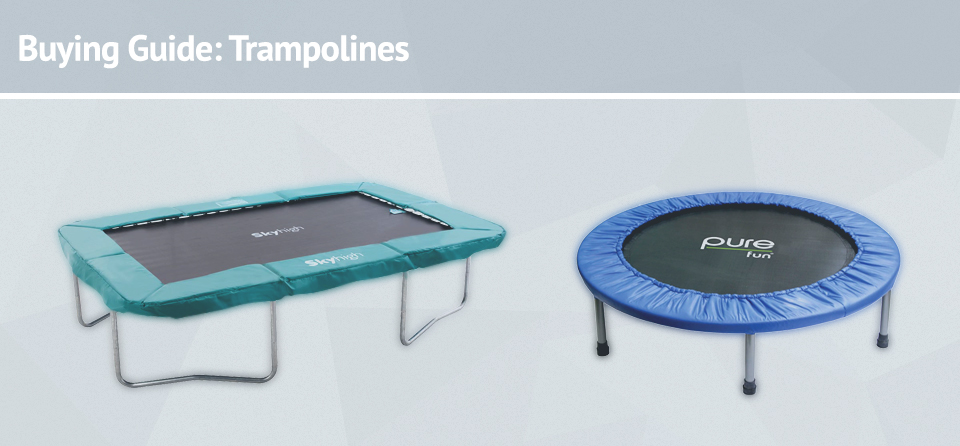Buying Guide: Trampolines
A trampoline can be an entertaining and enjoyable addition to a household, but it can be challenging to choose the right trampoline with a host of options at your fingertips. There are several features and specifications you need to be aware of in order to choose the best trampoline for your family.
Trampoline Components
Springs: Springs create a trampoline’s bounce. Springs line the outside edge of a trampoline. A higher spring count will contribute to a higher bounce. Shorter springs provide a low and controlled bounce.
Pads: Pads are the cushioned materials that line the edge of a trampoline. Pads are designed to protect bouncers from stepping on the springs of the trampoline. Thicker pads provide more protection for trampoline users who bounce close to the edges of the trampoline.
Enclosures: Trampoline enclosures line the outside of a trampoline with safety netting to prevent users from bouncing or stumbling off of a trampoline. Enclosures should fit perfectly around the edges of a trampoline to prevent accidents. Look for waterproof enclosures if your trampoline will be used outdoors.
Covers: A trampoline cover keeps the trampoline free of debris and reduces environmental wear-and-tear. Some covers are designed specifically to fit a variety of trampolines, while others are universal covers that can fit around multiple different models. Some trampoline covers provide drainage holes to keep your trampoline free of pooled water.
Frames: Trampoline frames can be welded or weld-free. A weld-free frame will be more resistant to damage and daily wear. Some frames come equipped with a UV coating to increase the longevity of the trampoline.
Beds: Trampoline beds are the netted materials that bounce users into the air. Beds may be UV treated to increase lifespan. Some trampoline beds include an X marker to indicate the safest spot to land on a trampoline.
Ladders: Trampoline ladders can be attached to a trampoline to provide easier, safer access for children or adults. Look for a nonslip ladder if your trampoline will be used outdoors. UV treatment will increase the life of a trampoline ladder. To ensure that users can safely maneuver on or off of a trampoline, a ladder should fit snugly onto a trampoline rather than resting against its edges.
Types of Trampolines
There are more types of trampolines available than you might think. The one that is best for your family will depend on how you plan to use it. Choose a trampoline that provides athletic support, gentle exercise, or outdoor recreation.
The Rebounder or Mini-Trampoline
These trampolines are compact, designed specifically for indoor use by a single person at a time. Rebounders can be tucked away for easy storage, which makes them a perfect fit for even the smallest home or apartment. Â Rebounders provide low-impact movement that can enhance your exercise routine. They can improve your balance and your circulation for improved health. Consider adding stabilizer bars in order to improve your coordination over time.
The Recreational Trampoline
A recreational or backyard trampoline can provide fun, relaxation, and exercise for an entire family. You can choose either a circular or rectangular recreational trampoline. Generally, buyers choose one or the other based on the space that they have and personal preference, but there are some benefits with each.
The Circular Trampoline
The most popular choice for rectangular trampoline users, circular trampolines tend to be the safest option for family fun. The circular shape of these trampolines allows them to evenly distribute bounce force to the entire trampoline, moving bouncers gently towards the center if they begin to stray to the edges of the structure. Circular trampolines use less steel than rectangular trampolines and are typically light enough to be assembled, moved, or disassembled as needed.
The Rectangular Trampoline
Rectangular trampolines are typically used by gymnasts and experienced trampoline users. All of the springs in a rectangular trampoline move in the same direction, which leads to higher bounces and a deeper rebound. Rectangular trampolines are typically constructed out of thick steel to create a safe, solid base for bouncing. Because their bases are heavy and solid, these trampolines may be more difficult to relocate or disassemble.
Children using a rectangular trampoline should be supervised at all times. An uneven landing on a rectangular trampoline can cause an unexpected change in direction that may lead to injury.
The Olympic Trampoline
Olympic or professional-grade trampolines are designed for athletic usage, providing maximum power and rebound. These trampolines should only be used by trained and experienced users.
Olympic trampolines rely on netting that is more widely spaced than the netting used in recreational trampolines. As a result, these trampolines are highly responsive to force. Olympic trampolines feature safety padding that is designed to cushion bouncers if they stray outside of the netting limits.
Designed to handle gymnastic feats as well as everyday usage, Olympic trampolines tend to be larger than recreational trampolines.
For the most part, choosing a trampoline is as easy as knowing how you plan to use it. Be sure to invest in safety features such as a net in order to make for a safer experience.







